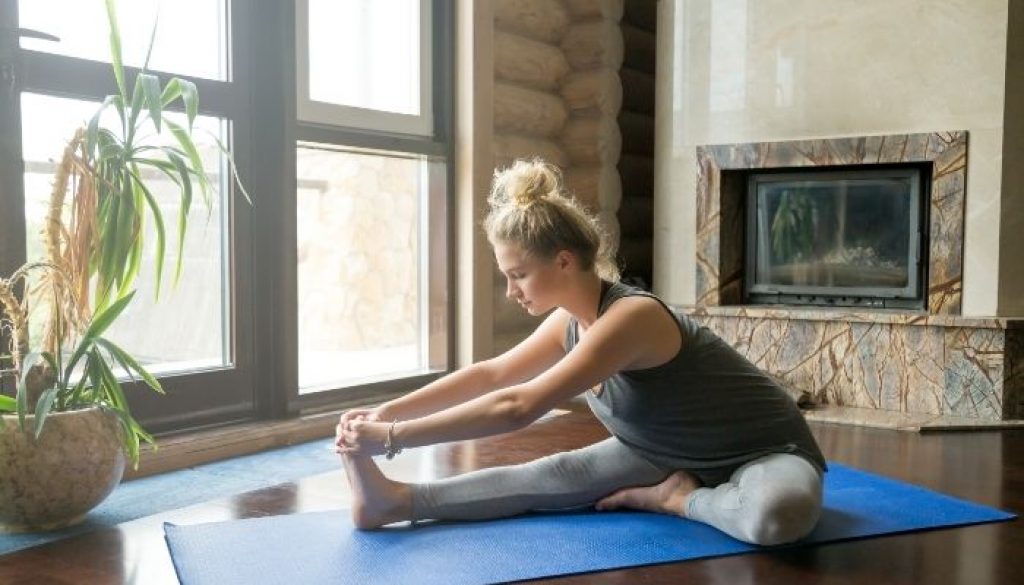The Benefits of Exercise While Working from Home

I’m delighted to share this guest post which originally appeared on the Yanre Fitness blog. Yanre has awesome resources including a newsletter to keep you in the know about all things fitness – subscribe here.
Advice from the Centers for Diseases Control and Prevention (CDC) is simple:
“Regular physical activity is one of the most important things you can do for your health.” The United Kingdom’s National Health Services agrees: “Exercise can reduce your risk of major illnesses, such as heart disease, stroke, type 2 diabetes, cancer by up to 50%, and lower your risk of early death by up to 30%.”
We also know that exercise is good for our mental health. It can improve your mood and help you get better sleep. Exercise has also been recommended for helping alleviate depression, stress, and anxiety, among other mental health challenges.
For many people, the daily dose of exercise comes from the steps they take when they go to work, the stairs they climb when moving from one office to another, and their time at the company gym. However, governments’ restrictions, as a result of COVID-19, have meant that many people are working remotely in the last few months.
While working remotely presents several benefits, it is not necessarily good for our bodies. It makes us move less, a situation that may lead to weight gain, fatigue, sleep problems, loneliness, social anxiety, and other long-term health issues. Therefore, an exercise routine is necessary when working from home.
In this article, we examine the benefits of exercise while working from home. We present the risks of a sedentary lifestyle resulting from a lack of movement when working remotely and the benefits of having an exercise regime. The article also presents some suggestions on creating a home gym and making the time to exercise regularly.
1. Health Risks of Working from Home
Not many can argue that working from home presents benefits. When you work from home, you don’t need to commute in heavy traffic. It could also be cheaper because you don’t have to pay for transport, and there is no need to buy food from the company cafeteria. However, it presents some risks to our well-being.
Less Movement
One significant risk of working from home is the lack of physical activities to improve overall health, which leads to a sedentary lifestyle. Walking to the train station or bus, dashing between different conference rooms, stepping out for lunch, among others, are examples of physical activities associated with working on-site or in an office setting.
Despite saving commute and traffic time, remote workers sit for hours attending business calls, teleconferences, and Zoom meetings. This leads to physical inactivity, which can lead to back pain and obesity. Working from home could also lead many to adopt non-ergonomic positions, such as laying on your bed or working on a couch, for an extended period while working.
A study published by Cambridge Open Engage, in May 2020, at the height of the Covid Pandemic, concluded that during the pandemic, Americans are becoming more sedentary than before—and the effects are likely to last long after the pandemic has passed. The study used a sample of 3,052 U.S. adults. Cambridge Open Engage is a research platform run by the Cambridge University Press.
The same study published on Cambridge Open Engage concluded that those who had been meeting the recommended levels of exercise before the pandemic reported an average of 32% reduction in physical activity when social distancing measures were introduced while those who were already sedentary continued to be sedentary.
Overworking and Less Time for Exercise
Another significant risk of working from home is work fatigue. A remote worker needs to combine the demand from their family with office responsibilities, such as managing the tools and technology to support work, maximizing time, and communicating with colleagues and leaders via chat or video calls.
Working from home can present time management issues, which could lead workers to spend more time working. In an article published by the Harvard Business Review, Laura M. Giurge and Vanessa K. Bohns note that “The lines between work and non-work are blurring in new and unusual ways, and many employees who are working remotely for the first time are likely to struggle to preserve healthy boundaries between their professional and personal lives.”
As employees find themselves working all the time, they end up with less time for other activities, including physical exercise. Added to this, when working from home, the fridge is always within easy reach, a situation that could result in eating more and gaining weight.
Social Isolation
With reduced physical contact with colleagues, a lack of social interaction can lead to poor sleeping habits, depression, loneliness, and substance abuse. In a study published by The Royal Society Publishing, Louise C. Hawkley and John P. Capitanio refer to the link between “deficits in social relationships” and “adverse health and fitness consequences.”
2. Benefits of Exercise While at Home
Exercise comes with several physical and mental health benefits, including longevity. Here are a few of the top benefits you would enjoy by exercising regularly while working from home.
Control Body Weight
Exercise helps control body weight. Along with a proper diet, regular exercise is essential in checking and managing body weight and preventing the risk of becoming obese. Obesity is the result of having more units of calories in the body than necessary.
To maintain your body weight, the calories gained from both food and drink must be the same as the quantity used daily. Therefore, to shed weight, you need to burn more units of calories through exercise. Eating more calories and burning less will lead to increased weight.
Improves Health
Exercise enables the body to manage insulin and blood sugar levels. It lowers the level of sugar in the blood and helps insulin work better. Making time for exercise reduces the risk of type 2 diabetes and helps manage the disease for those who already have it.
Working out regularly minimizes the risk of heart diseases. It improves blood circulation. The increased flow of blood causes oxygen levels in the body to rise. Consequently, this reduces the risk of heart diseases, such as heart attacks, coronary artery disease, and high cholesterol. A regular workout also helps lower blood pressure.
Mental Sharpness
Exercise helps to keep the cognitive and judgment skills sharp. As you exert your mental capacity while working remotely, exercise helps fuel your body to release proteins and other chemicals that develop the brain’s function and structure.
Better Sleep and Improved Mental Health
Exercise also improves sleep. Charlene Gamaldo, the Medical Director of Johns Hopkins Center for Sleep, agrees and notes that “exercise does, in fact, help you fall asleep more quickly and improves sleep quality.”
Working out, coupled with better sleep, improves mood and mental health. Physical activities discharge chemicals that help relieve stress and make a person feel more relaxed. Exercise helps you deal with work fatigue and reduces the risk of depression, a hazard associated with the loneliness and social isolation linked to working from home.
3. Types of Home Exercises
Exercise can be categorized into three types: Aerobic, anaerobic, and flexibility. Each one has its benefits.
Aerobic
Aerobic exercises involve cardiovascular activities, such as swimming, running, and brisk walking. Such exercises mainly use oxygen as fuel and keep the heart and circulatory system healthy.
A few examples of aerobic exercises you can practice at home include kickboxing, jumping jacks, running the stairs, jogging in place, and jump rope. You can achieve benefits from most of these activities with a 10 to 20 minutes workout.
Anaerobic
Anaerobic exercises are physical activities that mostly leverage the body’s glucose to develop muscles during workouts. They are usually done for a short interval but with high intensity.
Anaerobic exercises aid weight loss, promote metabolism, improve physical and mental health, and increase endurance and performance levels.
Examples of this type of exercise you can engage in at home include weight-lifting, sprints, and high-intensity interval training, where you rest in between a short period of intense workouts.
Flexibility
Flexibility exercises are activities that help to stretch the muscles and give freedom of movement. While practicing these exercises may not necessarily increase one’s endurance, it improves flexibility, shakes off discomfort, and makes everyday activities easier.
There are different types of exercises you can do at home to improve your flexibility. Some of these include various types of stretches like the simple seated stretch, triceps stretch, or frog stretch.
4. How to Create a Home Gym
Several benefits come with having a home gym. It encourages you to have a consistent exercise schedule without the need to leave your home. You need affordable pieces of equipment, which are basic yet essential, to set up your home gym.
Essential equipment will include a workout mat, resistance bands, a jump rope, dumbbells, a kettle bell, and a workout bench. You may need other pieces of equipment based on your workout routine, but the listed types of equipment are enough to get your home gym started.
You could supplement your gym equipment with things you already have, like bags of soil used as a kettle bell, a broom to improve shoulder mobility, and other such items easily found at home. However, it’s crucial to ensure that the equipment you use is safe.
5. How to Make Time to Exercise
It can be challenging to get off your seat and start a workout. You will always have that task that needs to be finished today, the kids are back from school and need your attention, and so on. We came up with a few suggestions on how you can make time for exercise:
- Create a dedicated space in the home for your workouts.
- Create a schedule and adhere strictly to a healthy work-life balance. It may take a while to find what suits you, but be committed to keeping your schedule.
- Make a habit of starting your day with an exercise routine.
- Start early before other people start to make demands on your time.
- Set alarms at reasonable intervals for you to stand up and stretch your muscles.
- Walk around during calls.A study conducted by Stanford researchers reveals that walking around improves your creativity.
- Set realistic exercise goals you can achieve indoors.
- Connect with others for exercises online.
- Do physical chores, such as hovering and ironing during breaks.






